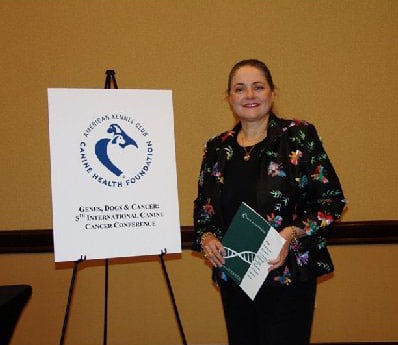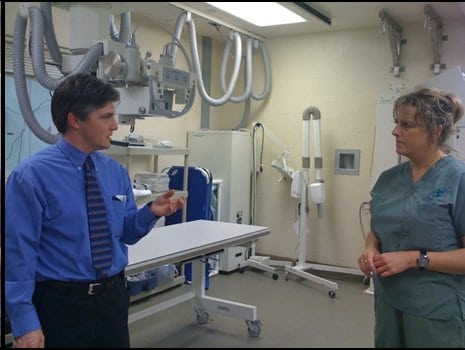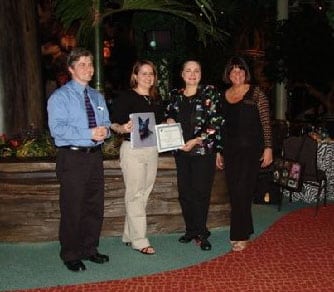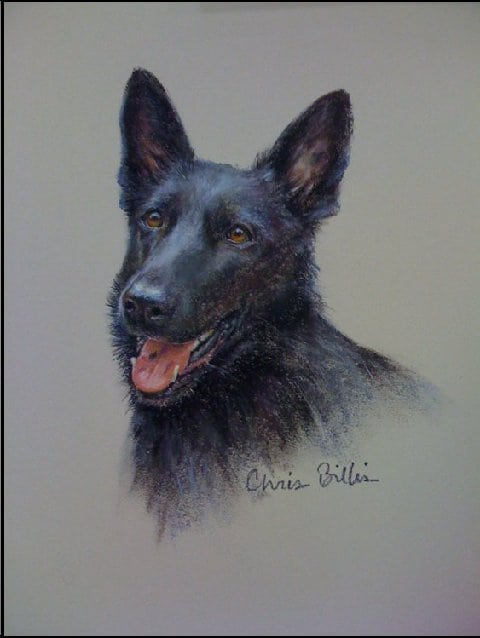The following Guest Blog post was generously written by our friend Luna‘s Mom, Sandra Thomas, Owner/Breeder, Burghard Shepherds, Lake Mary, Florida.
After learning about Sandra’s generous donation to the AKC Canine Health Foundation in memory of her beloved Luna, we asked her if she would share her exciting story about the day she got to present the first “Luna Award” recently in Orlando, Florida.
Luna’s Memory Lives On
Shortly after my two year old black German Shepherd dog, “Luna” was diagnosed with hemangiosarcoma on October 5th, 2007, I learned through the American Kennel Club AKC’s Canine Health Foundation of the research of Matthew Breen, PhD, (Professor Genomics), and Tessa Breen (Canine Genomics Sample Coordinator, Canine Cancer Genomics Program, North Carolina State University of Raleigh). I thought if nothing could be done for Luna, at least Luna might be able to do something for someone else. In fact, I enrolled all 12 of my dogs, including Luna’s parents and nine siblings, in his research program. I hoped that this family group might be useful to Dr. Breen in some way.
Luna had a long journey, she outlasted all of her vets’ predictions of two weeks to two months to live. She lived another 11 months after her formal diagnosis (and she had been limping several months prior to her diagnosis when we didn’t know what was wrong with her). Her journey included an initial surgery which removed part of the bone in her right hind leg to get the diagnosis, followed six months later with an amputation of the same leg, hemipelvectomy, chemotherapy, metronomics, and SAHA treatment. She lived life to the fullest as a “tripawd” for nearly another six months.
The Big Day: Presenting at Conference
 When Luna, then 3 years old, died on September 16th, 2008, I wanted to do something to try to keep her memory alive and to help further research in the field of canine cancer. That is when I made a donation to Dr. Breen’s research program in memory of Luna.
When Luna, then 3 years old, died on September 16th, 2008, I wanted to do something to try to keep her memory alive and to help further research in the field of canine cancer. That is when I made a donation to Dr. Breen’s research program in memory of Luna.
In response to the donation, Dr. Breen suggested that part of the donation go to an award to the “best presentation or poster” at the “Genes, Dogs and Cancer: 5th International Canine Cancer Conference” to be held February 13 – 15, 2009 at the Royal Plaza Hotel in Orlando, Florida. Dr. Breen, who chaired the conference which was open to all scientists, veterinarians, and dog fanciers with a scientific interest in cancer, suggested we call the award the “Luna Award for Advances in Canine Cancer Research“. Dr. Breen felt that this award, in his words, would “help keep her memory alive, not just among ourselves, but across the broader canine cancer genomics community.” And, he invited me to present the award personally at the conference as another way to remember our special Luna .
Recently, the “Luna Award” became a reality. The award was given at a banquet held Saturday, February 14th, 2009 at the “Conservation Station” inside the Animal Kingdom Park at Disney World in front of 100 of the world’s leading canine cancer researchers. There were many researchers from all parts of the country who made exciting scientific presentations. Some of the researchers were those whom I contacted by phone after Luna’s diagnosis, including Dr. Cheryl London and Dr. William Kisseberth from The Ohio State University and Dr. Matthew Breen and Dr. Steven Suter from North Carolina State University at Raleigh (Dr. Suter is currently doing ground breaking bone marrow transplants on dogs with lymphoma and other types of canine cancer). In addition, Luna’s veterinarian, Dr. Rowan Milner, from the University of Florida in Gainesville had a poster presentation at this same conference. Some of the abstracts presented at the AKC Canine Health Foundation conference are listed here.
After corresponding by email with Dr. Breen and his wife, Tessa, for nearly a year, I finally met Dr. Breen at the conference hall and we discussed the award and who he felt would be the best recipient. We decided that a young researcher with a bright future would be an appropriate candidate. I was very excited about the presentation and wondered who would be selected that evening. After the lectures were completed for the day, everyone attending the conference boarded two large tour buses which took us from the Royal Plaza Hotel to a special private entrance at the Animal Kingdom Park. Once inside the park, we were dropped off at the “Conservation Station” where the evening’s events would unfold.
Behind the Scenes at Disneyworld
Before the dinner, we were treated to a behind the scenes tour of the Animal Kingdom “hospital” which included three operating rooms, a radiology suite, a laboratory, and other facets of the health care system that Disney had created for its many wild and exotic animals, both those in captivity as well as those who lived in the wild on the huge Disney property. The tour was fascinating. Safari clad Disney employees also walked around during the outdoor cocktail hour and indoors during dinner carrying live animals, including an Indigo snake (which I petted), and a “Screaming Hairy Armidillo” (who was very quiet in his little acrylic cage), and a skink.
At the banquet, I was seated at a table with Dr. Breen and Dr. Terry Warren, who is the new Executive Director and President of the American Kennel Club’s Canine Health Foundation. I had a great time getting to know them better and learning more about their goals for canine cancer research. I learned that the Luna Award would be one of three awards presented that evening, and that the Luna Award would be the final award announced.
When it was time for the Luna Award to be announced, Dr. Breen invited me to join him at the microphone. He had asked me to speak for several minutes about Luna before the winner would be announced. As I held up a picture of a portrait I had done of Luna by Christine Billis, I shared my thoughts over the microphone to a hushed room:
“Strong. Fast. Brave. These are the words which described my beautiful black 2 year old German Shepherd Dog, ‘Luna vom Burghard.’ She was an active and athletic dog who was one of ten puppies born to my two German imports, Eik vom Blausteinsee and Kora von der Bultersteige. This puppy had an abundance of joie de vivre, prey drive, and personality.
“Shock. Disbelief. Despair. These are the words that described what I felt on October 5, 2007 when I received a phone call from Luna’s vet with a stunning diagnosis. Her words hit me like bullets: “Hemangiosarcoma. Primary bone. Unusual presentation…A few months to live…Options: amputation, hemipelvectomy……chemo…no cure……aggressive.” That night as I walked Luna in the back yard it was raining hard–it matched my emotions. I wrote in my diary that night, “I don’t know what is falling harder, the rain or my tears.
As a breeder and owner of 12 German Shepherds, I had not encountered this disease. I didn’t know anything about it. Countless hours of research on the Internet, however, made me very familiar with this horrible condition. Some of you here tonight may remember my calling you about Luna last year; sadly, I learned that there was little that could be done. Shortly after Luna was diagnosed, I learned through the AKC’s Canine Health Foundation of the research of Dr. Matthew Breen and Tessa Breen. I thought if nothing could be done for Luna, at least Luna might be able to do something for someone else. In fact, I enrolled all 12 of my dogs in his research program. I hoped that this family group might be useful to Dr. Breen in some way.
Through amputation, hemipelvectomy, chemo, metronomics, and SAHA, nearly a year after diagnosis, Luna’s spirit shone through the adversity like a full silvery moon in a clear night sky. As hard as we tried, though, you know how this story ends. Metastases to the lungs and brain forced me to bring her young life to an end on September 16, 2008.
As the president of the American Hemochromatosis Society, I know the importance of genetics and am a staunch supporter of genetic research. I feel that genetics hold so many answers for our medical mysteries. It is an honor to be here tonight to present the “Luna Award for Advances in Canine Cancer Research” in memory of my beautiful German Shepherd dog–Luna–who fought bravely and was an inspiration to those who knew her. I would like to applaud the work and research that all of you are doing; and, your ongoing quest to find answers to these canine cancers, answers which may help humans as well. I wish you God’s speed in your quest for a cure for cancer; I know that it can be done.”
 The Winner: Jennifer McCleese, Ohio State University
The Winner: Jennifer McCleese, Ohio State University
My short speech was met with warm applause and then Dr. Breen announced the winner, a young researcher, Jennifer McClesse, from the Department of Veterinary Biosciences, College of Veterinary Medicine, The Ohio State University in Columbus, Ohio.
I had the opportunity to speak with Jennifer after dinner, and learned that she received her BS in Animal Science from the University of Kentucky followed by her DVM from Oklahoma State University. She entered the combined PhD/Clinical Pathology Residency at The Ohio State University in 2005, joining Dr. Cheryl London’s lab to research the mechanisms involved in malignant transformation which promote the development of osteosarcoma, as well as novel therapies for treatment. I was also very interested to learn that she is from a small town in Kentucky, just outside of Lexington. My late mother, who died from hereditary hemochromatosis (iron overload disease) and who is the reason for my founding the American Hemochromatosis Society was born and raised in Mt. Sterling, Kentucky, in the heart of the bluegrass, and very near Winchester, where Jennifer was born. In fact, my mother’s childhood home, is on the “Winchester Pike” which leads to Winchester. I thought that was a very interesting “coincidence”.
The following information explains more about the research of Dr. London and Jennifer:
The novel HSP90 inhibitor STA-1474 exhibits biologic activity against osteosarcoma cell lines.
Jennifer K. McCleese1, Misty D. Bear1, Stacey L. Fossey1, Robert M. Mihalek2, Kevin P. Foley2, Weiwen Ying2, James Barsoum2, Cheryl A. London1. 1Department of Veterinary Biosciences, College of Veterinary Medicine, The Ohio State University, Columbus, OH 2Synta Pharmaceuticals Corp., Lexington, MA
Osteosarcoma (OSA), the most common malignant bone tumor in dogs and children occurs with a higher frequency in the canine (10,000 cases/yr) versus the human (1,000 cases/yr) population. In both species, no significant improvements in treatment have been made for over 15 yrs. Heat shock protein 90 (Hsp90), a molecular chaperone responsible for ensuring several kinases, hormone receptors, and transcription factors maintain an active functional state, represents an attractive therapeutic target for cancer since many of its client proteins contribute to tumor growth and survival. We hypothesized that Hsp90 exists in a multi-chaperone active complex in OSA cells, allowing selective targeting of malignant cells, promoting client protein down-regulation and subsequent cell death. To test this, we used a novel Hsp90 inhibitor, STA-12-1474, to block ATP-dependent Hsp90 activity. Our data demonstrate dose and time dependent inhibition of canine and human
OSA cell viability ultimately resulting in apoptosis, with enhanced sensitivity for malignant compared to normal canine osteoblasts. Hsp90 was associated with cochaperones p23 and Hop in canine OSA cells but not normal canine osteoblasts, indicating formation of an active complex in the malignant cells. Inducible Hsp70 levels increased with STA-12-1474 treatment, consistent with induction of cellular stress following Hsp90 inhibition. STA-12-1474 promoted down-regulation of rhHGF induced p-Met and Met as well as, p-Stat3, p-Akt and Akt, while total Stat3 levels remained unchanged. Loss of cell viability following STA-1474 treatment was enhanced in the presence of doxorubicin. STA-12-1474 inhibited tumor growth, promoted apoptosis and downregulated p-Met, Met, p-Akt, and Akt in OSA xenografts. In summary, these data indicate that Hsp90 represents a relevant target for therapeutic intervention in OSA.”
After the bus returned to the hotel, I gave Dr. Breen a copy of the “tripawds 2009 calendar” before I returned home. He loved the calendar and said he would put it up in his office. I pointed out Luna’s photo for the month of July with her colorful red, white, and blue bandana around her neck, and showed him the photo of “Jerry” on the cover of the calendar and explained who he was and what the Tripawds web site is all about. I heard from Dr. Breen a week later telling me that the calendar was now hanging in his research lab and being enjoyed by everyone there.
I learned that this conference is held every two years and I look forward to giving the Luna Award again in memory of Luna. It was indeed a memorable and special evening for me since it allowed me to once again share my thoughts about Luna and how much I loved her.”
Other links related to this story:
Man’s Best Friend Joins the Fight Against Cancer

Dear Sandra,
This is wonderful work and I am sure Luna is so proud of you! You are taking being proactive to a new level! Please keep us posted on any findings that are made as part of this research…
Kim & Buster
ps beautiful portrait of Luna as well
Dear Friends,
Thank you so much for posting this information about Luna on your blog. You did such a great job–it just brings tears to my eyes…
Thanks again for all you do…
Sandra Thomas & “Angel” Luna